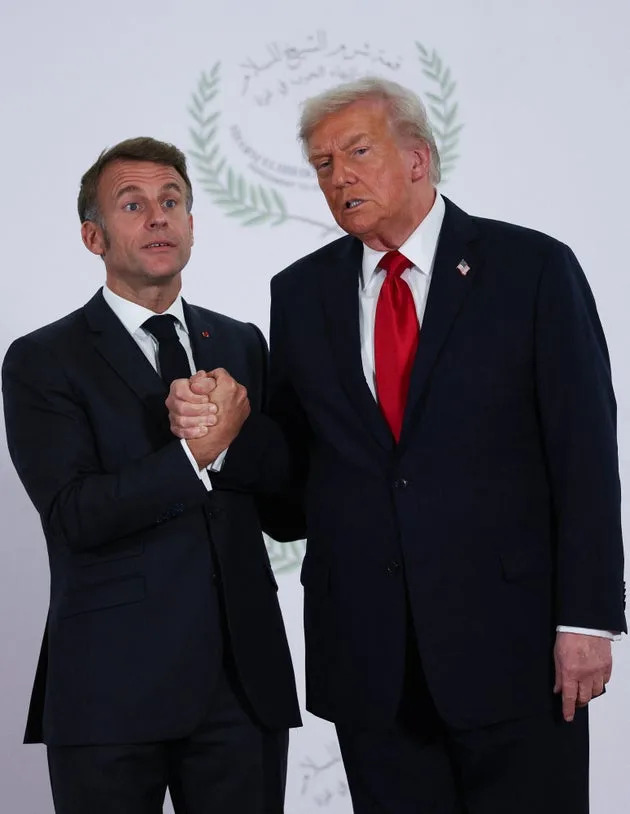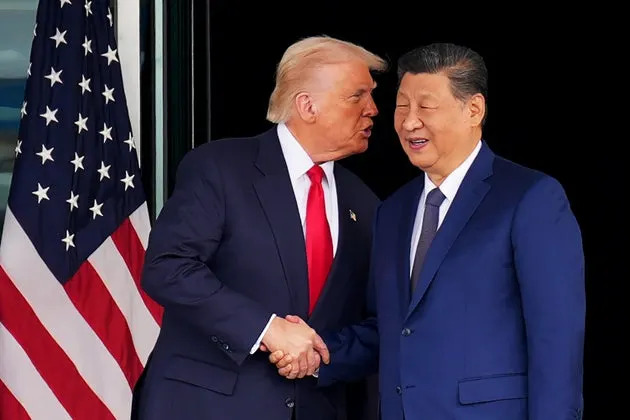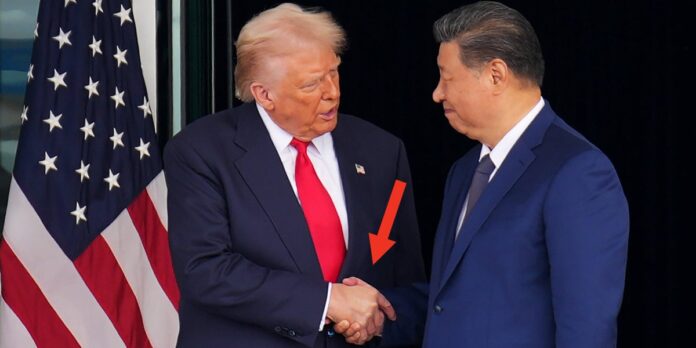President Donald Trump met with Chinese President Xi Jinping in South Korea on Thursday for tariff negotiations the U.S. president later rated a “12” on a scale of 1 to 10.
However, the handshakes between the leaders sparked a separate conversation when Fox News’ Michelle Backus gushed that the exchange demonstrated Trump’s “control” of the situation.
Politics: ‘Slobber’ Over Trump On Fox News Reaches ‘Sickening’ Extreme Over 1 Brief Moment
“And you can see the way he’s shaking his hand, President Trump has control of that room, and I have a lot of confidence in this meeting,” Backus said.
Though critics found this fawning to be a bit much, it did raise the question of what body language might actually say about the dynamics between the two men. HuffPost spoke with body language experts to better understand what might have been going on during the parts of their conversation we could see — and their responses were telling.
President Donald Trump met with Chinese President Xi Jinping, and their greeting and parting stood out to body language experts. Getty Images/Huffpost
Trump knows how to get the “power position,” at least at first.
It’s no secret that looking powerful is important to Trump, and his efforts were on full display at the beginning of his meeting with Xi.
For one, Trump got himself situated on the left, a sought-after “power position” that gives him the visual “upper hand” in photos, as Traci Brown, a body language expert and behavior analyst, told HuffPost.
Life: Body Language Experts Reveal Their Thoughts On Trump’s Major Kiss Fail At The Inauguration
“Trump is on the left,” Brown said. “That’s the power position, politicians fight for it.”
Trump did have one out-of-character move at the start that stood out, according toPatti Wood, a body language and nonverbal communication expert and author of “SNAP: Making the Most of First Impressions, Body Language, and Charisma.” While he did make the “first action” of the handshake (which typically demonstrates the most power), the positioning of his hands might tell a different story.
“Because I’ve seen him shake hands and analyzed it hundreds of times, in the first greeting, it’s interesting that Trump turned and put his palm up,” Wood said. “Typically that’s not his style, because that’s supplication: ‘I have less power, I am palms up, I am less powerful.’”
Brown also notes the “palm up” gesture, noting it can also show a “welcoming and a hospitality mindset.”
Life: Why Sports Betting Apps Are So Addictive, According To Experts
As the exchange went on, Trump continued to employ more of the power moves that are familiar if you keep up with his typical body language in these types of exchanges: mainly, pulling his counterpart closer to wherever he wants them (also engaging in other forms of touch) and attempting to dictate when the action both starts and ends.
“Trump reaches in to pat Jinping’s back,” Brown added. “That can be a show of control — Trump could move Jinping around if he wanted to.”
And that physicality is pretty consistent: “Trump does something he often does, he pulls [Xi’s] hand over in front of his body. So he’s taking a dominant action to pull rather than stop and do a normal handshake,” Wood noted.
“He’s taking his left hand and arm and patting his back. There’s two symbols: Patting can be an affectionate move or it can show ‘I’m in charge’ … It becomes another dominance signal to say, ‘I can hit you, and I can hit you on the world stage.’”
Keeping the hand for a long time becomes noticeable in these photo-ops, Wood says, and it’s traditionally not how these rituals are done. “Again, it’s become more standard for Trump, though typically in these situations of world leaders meeting together on the world’s stage, under everybody’s eye, you don’t have a handshake that becomes a battle hold.”
The handshake also rejects rituals.
While there are varying protocols and cultural differences at play, Wood notes that, typically, a handshake is about three to five pumps. And it’s super rare for the shake to continue until reporters begin asking questions, which is what happened in Trump and Xi’s exchange.
Life: The Funniest Posts From Women This Week (Oct. 18-24)
“You see that Xi Jinping is ready for it to end. Part of what signals that nonverbally, he is leaning slightly away, both his shoulder and his head are leaning slightly away, he is orienting and responding face-on toward the journalist. Trump is slightly oriented toward Xi Jinping and just holding on,” Wood said. “A normal handshake is equal distance between two people. But when Trump pulls the hand and holds it in front of him, he’s showing, ‘I’m the one in charge, I have dominance, I’m going to win.’”
Wood, who studies greeting rituals and their symbolic significance, noted that the ritual of the handshake is traditionally meant to be a gesture of peace. Literally, it is meant to demonstrate you do not have a weapon in your hand or up your sleeve (that’s what the shaking is for). It’s meant to initiate the beginning of the “game” — and to acknowledge the equal footing of the two parties that are meeting.
“What Trump is signaling is the antithesis of the normal handshake, which is equality,” Wood notes. “It says, ‘We’re both safe here and we’re both equal here.’ Instead of the ritual, this is: ‘I want to show you that I’m going to win, that I have power and I’m not letting you go.’”

U.S. President Donald Trump and French President Emmanuel Macron pose for a photo at a world leaders’ summit on ending the Gaza war in Sharm el-Sheikh, Egypt, on Oct. 13, 2025. Suzanne Plunkett/Pool Photo via AP
The exchange ends on a less-than-dominant closer.
While his initial dynamic with Xi points to Trump maintaining his dominance, Wood notes that the handshake post-negotiation might tell a different story.
“After the negotiation, Trump does something that I’ve seen him do more often, he whispers in the ear. All of us want to know what he’s saying, but what that does symbolically is that they have a secret,” Wood said. “We don’t know what’s true, but symbolically, it looks to us that Trump is telling him something. That they have a secret between themselves.”
Life: Neutrogena Recalls Over 15,000 Packages Of Makeup Wipes Over Bacterial Contamination Concerns
Wood noted that, having analyzed hundreds of these exchanges, this isn’t inherently weird — and often after the ritual of handshakes, leaders will part ways with a laugh or a joke or a clear moment where the tension has lifted and they can revert to being “themselves” again.
“Typically, it’s almost like two buddies, a laughing response,” Wood said, “while Trump, in that ending handshake, has a forced grin.”

U.S. President Donald Trump and Chinese President Xi Jinping shake hands as they depart following a bilateral meeting at Gimhae Air Base on Oct. 30, 2025, in Busan, South Korea. Andrew Harnik via Getty Images
From there, the dominance display also starts to lose its power. One thing to know, Wood says, is that these sorts of televised meetings between leaders on the world stage are fairly formalized. There are people who brief all parties on protocol and where they are meant to go throughout the event. They also typically have time to practice or are given that explicit direction.
In Trump’s case, he ended up asking for directions and eventually walking Xi to his car.
“Usually, they will come down to that neutral point at the bottom of the stairs and go their separate ways,” Wood said. “It’s odd because it would symbolically show less power by Trump. To me, that was odd, and it symbolically looked like he had less power because he walked to the car and got lost; he just didn’t know where to go.”
“Again, because I’ve read so many of these: Usually they practice ahead of time or are told ahead of time and remember which way to go. So that’s odd. I guess it’s just important to say that’s not normal.”
And that whimper of an ending, despite all attempts at a bang, is notable from a nonverbal communication perspective, too. Just as the primacy effect makes first moves more memorable, the recency effect puts more focus on the final move, too.
“We have the primacy effect, the first handshake, and the recency effect is the last handshake,” Wood said. “He did a lot of effort to look powerful in the initial greeting handshake, and he ended up not looking as powerful with the ending handshake. The recency effect, the very last thing you say or do.”
Related…
Donald Trump, President Xi Jinping, body language, Trump On Fox News Reaches, power position, Patti Wood
#Trumps #Odd #Body #Language #Meeting #Chinese #President #Spoke #Volumes #Experts

